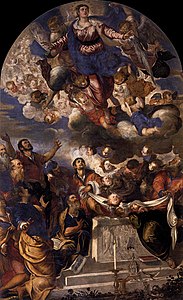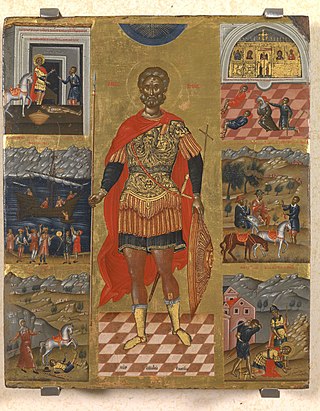
Cretan School describes an important school of icon painting, under the umbrella of post-Byzantine art, which flourished while Crete was under Venetian rule during the Late Middle Ages, reaching its climax after the Fall of Constantinople, becoming the central force in Greek painting during the 15th, 16th and 17th centuries. The Cretan artists developed a particular style of painting under the influence of both Eastern and Western artistic traditions and movements; the most famous product of the school, El Greco, was the most successful of the many artists who tried to build a career in Western Europe, and also the one who left the Byzantine style farthest behind him in his later career.

Dionysius of Fourna was an author, educator, painter, and monk. He was one of the most influential painters of the 18th century. He was a monk on the isolated self-autonomous monastery of Mount Athos. He was a self-taught painter. He was exposed to the works of the Cretan School and Heptanese School but choose to paint in the traditional style. His works are a mixture of different styles including the palaeologan renaissance. He was active from 1685 to 1744. According to the Hellenic Institute, two of his fresco and ten of his icons have survived. He was active while the Heptanese School flourished. His contemporary at the time was the painter David both artists belong to a class of their own. His student and coworker was famous Greek painter Kyrillos Foteinos. He was from Chios. Some of his other students were Zacharias Vakos, Agapios and two painters known as Petros. Dionysios was also the author of a famous manual on painting.

The Heptanese school of painting succeeded the Cretan school as the leading school of Greek post-Byzantine painting after Crete fell to the Ottomans in 1669. Like the Cretan school, it combined Byzantine traditions with an increasing Western European artistic influence and also saw the first significant depiction of secular subjects. The school was based in the Ionian Islands, which were not part of Ottoman Greece, from the middle of the 17th century until the middle of the 19th century. The center of Greek art migrated urgently to the Ionian islands but countless Greek artists were influenced by the school including the ones living throughout the Greek communities in the Ottoman Empire and elsewhere in the world.
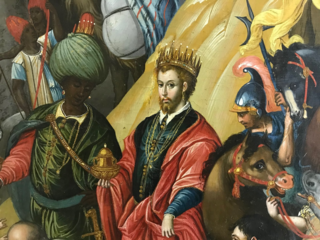
Michael Damaskenos or Michail Damaskenos was a leading post-Byzantine Cretan painter. He is a major representative of the Cretan School of painting that flourished in the 16th and 17th centuries. Painters Georgios Klontzas and Damaskenos were major contributors to the Cretan School during the same period. Damaskinos traveled all over the Venetian Empire painting. He remained loyal to his Greek roots stylistically but incorporated some Italian elements in his work. He was strongly influenced by the Venetian school. He painted parts of the Cathedral of San Giorgio dei Greci. Damaskenos has 100 known works. He influenced the works of Theodore Poulakis.

The Modern Greek Enlightenment was the Greek expression of the Age of Enlightenment. Greek Enlightenment was an intellectual and philosophical movement that occurred in the Greek community. Most of the Greek people were scattered all over the Ottoman Empire. Some lived on the Ionian Islands, Venice, and other parts of Italy. One of the early proponents of Greek Independence was Leonardos Philaras ironically the Modern Greek enlightenment began shortly after his death. There were constant uprisings throughout the Ottoman Empire countless Greeks lived in Venice and fought for the Venetian Empire against the Ottomans. Some Greek painters living in Venice who fought in the war included: Victor (painter), Philotheos Skoufos, and Panagiotis Doxaras. Greek painting dramatically shifted during the Modern Greek Enlightenment. The traditional Byzantine Venetian style that was prevalent in the Cretan School faded in the Heptanese School. Painters such as Doxaras drastically shifted the traditional style. He integrated oil painting, replacing the egg tempera technique.

Nikolaos Doxaras. He was a Greek painter and teacher. His father was famous painter Panagiotis Doxaras. Panagiotis Doxaras was the father of the Greek Rococo and the Modern Greek Enlightenment in art. They are both prominent members of the Heptanese School. They refined Greek art bringing the Maniera Greca into the Maniera Italiana. Artists he influenced include: Nikolaos Kantounis, Nikolaos Koutouzis and Gerasimos Pitsamanos. His influence can be seen in some of Nikolaos Kantounis's paintings notably The Assumption. Nikolaos taught famous painter Nikolaos Koutouzis. Both Nikolaos Koutouzis and Doxaras artistic style refined the art of the Ionian Islands. Venetian painting influenced countless Greek artists who were living in the empire. From Michael Damaskinos to Theodore Poulakis. Twenty years after Nikolaos's death the style came to an end due to the Fall of the Republic of Venice. A new artistic style developed after the Greek Rococo which coincided with Neoclassicism in the rest of Europe called the middle Modern Greek Enlightenment in art also known as Neo-Hellenikos Diafotismos.

Ilias or Elias Moskos was a Greek educator, shipping merchant and painter from Crete. The last name Moskos was associated with three famous painters of the Cretan School alive during the same period, along with Ioannis Moskos and Leos Moskos, possibly his relatives. Elias incorporated maniera greca with the Venetian style. Theodore Poulakis and Moskos brought the art and style of Crete into the Heptanese School of the Ionian Islands. Some of his work was inspired by Angelos Akotantos. He was affiliated with other artists such as Philotheos Skoufos. He is often confused with Leos Moskos. His son was not Ioannis Moskos although they were probably related. Elias most popular painting is Christ Pantocrator. Fifty-two of his paintings survived.
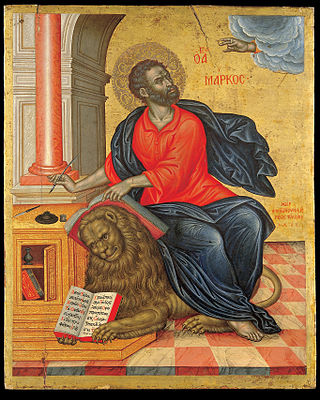
Saint Mark is a tempera-on-wood painting created c. 1657 by Emmanuel Tzanes. Tzanes was a Cretan painter who migrated to Corfu and Venice. He settled in Venice with his brothers Konstantinos Tzanes and poet Marinos Tzanes. Konstantinos was a famous painter. Their combined existing works number over 150. Emmanuel replaced Greek painter Philotheos Skoufos as the priest of San Giorgio dei Greci.

The Crucifixion is a tempera painting by Konstantinos Paleokapas. Paleokapas was a Greek painter from the island of Crete. He was active during the early part of the 1600s. Six of his works survived, four are signed. The Crucifixion is one of the most popular events in human history. The scene has been duplicated countless times. Many crucifixion paintings were created by painters from the island of Crete. Some painters included El Greco, Andreas Pavias, Georgios Markazinis and Ioannis Moskos. Paleokapas created his own version of the popular subject. His crucifixion painting followed the prototype of many other paintings thematically. He added both the dice players and the resurrection of the dead. Andreas Pavias’s The Crucifixion (Pavias) and Margkazinis’s The Crucifixion (Margkazinis) both feature the popular pictorial representation of Mathews gospel. Paleokapas’s Crucifixion is located at the Gonia Monastery in Crete.

The Virgin and Child on Bronze is an egg tempera painting by Greek painter Elias Moskos. Moskos was originally from Crete. The painter migrated to Zakinthos. Two other painters with the name Moskos were active during his lifetime. They were Ioannis Moskos and Leos Moskos. All three painters were affiliated with Venice. Fifty-two of Elias's paintings survived. It is difficult to characterize the work of some painters belonging to the late Cretan School. Some artists also belong to the Heptanese School. The technical migration from the maniera Greca of Cretan-Venetian painting to the more refined Ionian-Venetian style is visible in the works of Elias Moskos and Theodoros Poulakis. His painting of the Virgin and Child drastically migrates from the traditional mannerism prevalent in Cretan painting. The painting clearly belongs to the Heptanese School. His painting of the Virgin and Child is at the Benaki Museum in Athens Greece.

The Virgin Glykofilousa with the Akathist Hymn is a tempera painting created by Greek painter Stephano Tzangarola. The work is a symbol of the craftsmanship of the Heptanese School and the evolution of Greek painting from the Byzantine style to the Cretan Renaissance style. Tzangarola was originally from Crete and migrated to Corfu. The Ionian Islands became the artistic center of the Greek world. He was active from 1675 to 1710 during the Greek Baroque period and Rococo. Twenty-two of his works survived. His student was famous Greek painter and Archpriest Andreas Karantinos.

The Deposition from the Cross or Descent from the Cross is a tempera painting created by Greek painter Stylianos Stavrakis. He was active during the early part of the 1700s. His nephew and brother were also famous painters. His nephew Demetrios Stavrakis was also his pupil. He was also a goldsmith. Most of his works were completed on the island of Zakynthos. He was a representative of the Heptanese school and Greek Rococo. Fourteen of his paintings survived.
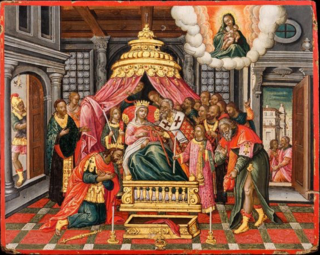
The Miracle of the Holy Belt was completed by Theodore Poulakis. He was a Greek painter originally from the village of Chania, Crete. He was associated with the Cretan School. He eventually migrated to the Ionian Islands. He was a member of the Heptanese School. He settled on the island of Corfu. He was a famous teacher. He signed a six-year contract to teach painting to Marinos Damistras son Tzorzi. The contract stipulated that his student had to follow him to Venice. Poulakis frequently traveled all over the Venetian Empire. During one period of his life, he stayed in Venice for over 13 years. He was very active within the painting community. He was also involved with the prestigious quarantia council. One hundred thirty of his work survived. The Girdle of Thomas also referred to as the miracle of the holy belt is a sacred relic located at Prato Cathedral in Tuscany, Italy.

Lamentation of Christ is an oil painting created by Greek painter Nikolaos Kantounis. He was a painter and teacher. He was a priest. His teachers were famous painters Ioannis Korais and Nikolaos Koutouzis He was a representative of the Heptanese School. His artwork was created during the Neoclassical and Romantic periods in Greek art. He was active on the island of Zakynthos from 1782–1834. He was one of the earliest members of the modern Greek art period. Over 164 of his paintings have survived. He is known for painting many portraits. He was a member of the secret organization for Greek Independence called the Filiki Eteria. Towards the end of his life he was honored with the rank of Grand Sakellarios.

The Holy Towel is a tempera painting completed in 1659 by Emmanuel Tzanes. He was a representative of the Late Cretan School and the Heptanese School. His brothers were the painter and poet Marinos Tzanes and the painter Konstantinos Tzanes. One hundred thirty works of art are attributed to Emmanuel. He is one of the most important Greek painters of the 17th century along with Theodoros Poulakis. He was from Rethymno Crete. He was active from 1625 to 1690. He was the priest of San Giorgio dei Greci in Venice for thirty years.

The Holy Family is an oil painting created by Greek painter Panagiotis Doxaras. He was a prominent member of the Heptanese School. He was also an author. His son Nikolaos Doxaras was also a famous painter. Panayiotis was from a small village named Koutifari, close to Kalamata. He moved to Zakynthos at a young age. He studied painting with famous painter Leos Moskos. He traveled all over the Venetian empire with the famous artist including Venice. He studied painting in Venice for five years. He became a theoretical painter. He wrote several books on painting. He traveled all over the Ionian Islands. He lived in Lefkada, Zakynthos, and Corfu. He frescoed the ceiling of Panagia Faniromeni in Zakynthos. Eighteen of his paintings survived.

Saint Spyridon, John the Baptist, Saint Peter and Saint George is an oil painting created by Greek painter Nikolaos Koutouzis. He was a prominent member of the Heptanese School of painting. He was from the island of Zakynthos. He studied with Nikolaos Doxaras and Giovanni Tiepolo. He was an active painter for over fifty years. One hundred and thirty-six paintings are attributed to the artist. He was active from 1750 to 1813.
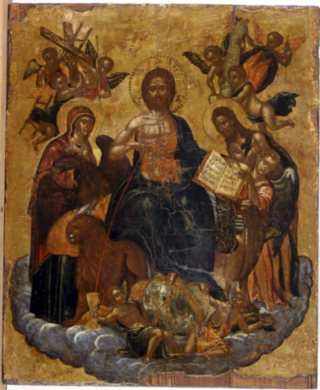
Tribute to the Eucharist was a painting made of egg tempera and gold leaf on a wood panel. The portable icon is attributed to Greek painter Michael Damaskinos. Damaskino's existing catalog features over 100 known works. He was a member of the Cretan school of painting. He was from the island of Crete. His contemporaries were Georgios Klontzas and El Greco. Damaskinos traveled all over Italy for over twenty years. He spent a significant amount of time in Venice. He adopted Italian mannerisms. He applied these new attributes to his paintings. He was friends with sculptor Alessandro Vittoria. He had a collection of drawings obtained from other Italian artists. Namely the Mannerist Parmigianino. He was also exposed to the magnificent works of Italian painter Raphael.

Nikolaos Gripiotis aka Nicolò Gripioti, was a Greek painter and teacher. He was a prominent member of the Cretan School in the early 1500s, working alongside such practitioners as Michael Fokas and Giorgio Miçocostantin. No work survives bearing his signature, but documents from the period record thousands of icons produced by his workshop. Nikolaos's son Ioannis Gripiotis also became a prominent painter. The family was related by marriage to Arsenius Apostolius.

Michael Fokas, also known as Migiel Fuca, was a Greek icon painter and art instructor. He came from a prominent family of painters, the founders of the Cretan School; working in this style, Fokas's workshop mass-produced icons for Greek and Italian clients. No surviving painting bears Fokas's signature, but history has preserved a commission for 200 icons which he received on July 4, 1499. This important document charges Fokas to produce works based upon the prototype Madre della Consolazione, originally created by Nikolaos Tzafouris and modeled after Giovanni Bellini.



